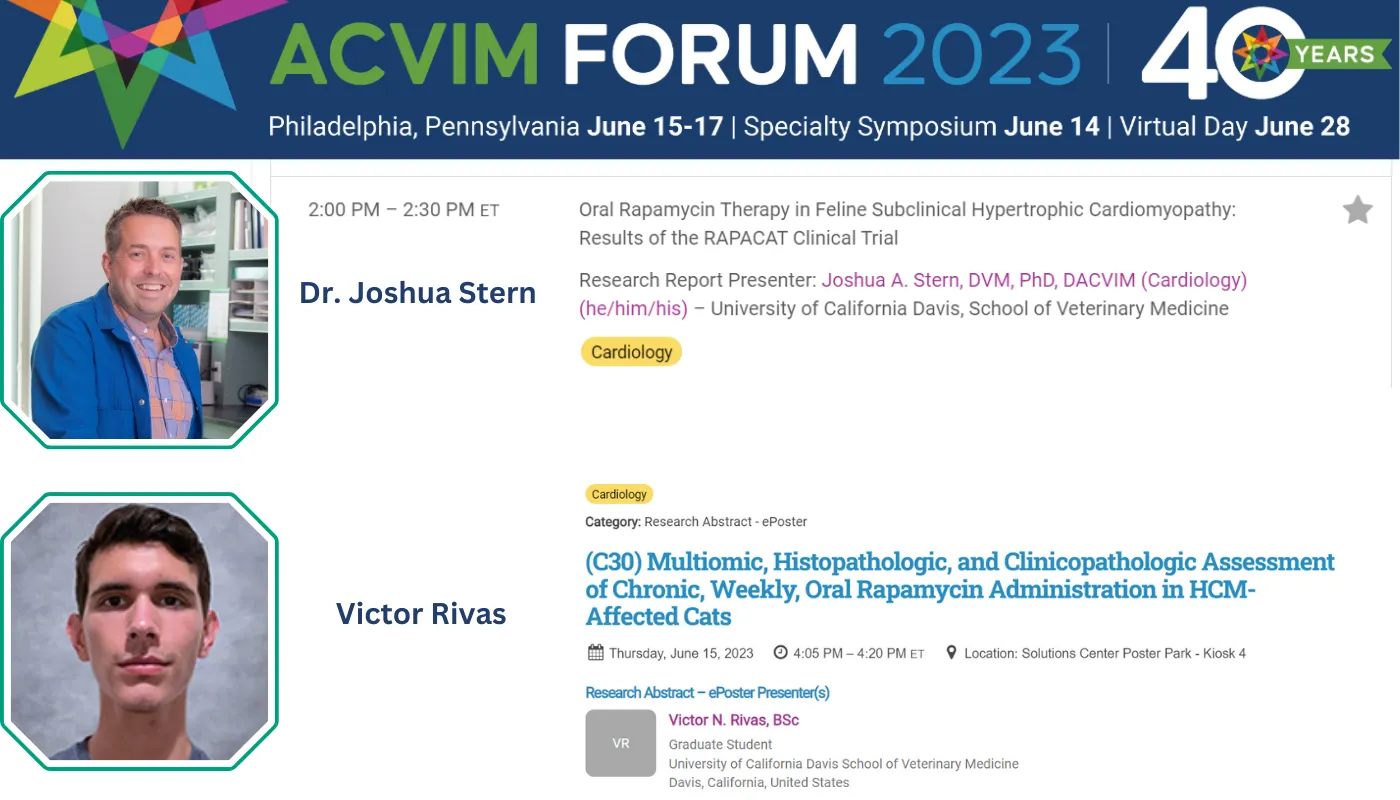
Cutting edge Feline Hypertrophic Cardiomyopathy Research to be presented to the American College of Veterinary Internal Medicine (ACVIM)
Two exciting pieces of feline hypertrophic cardiomyopathy (HCM) research are to be presented to the American College of Veterinary Internal Medicine (ACVIM) this year on their 40th anniversary. At TriviumVet we are extremely proud to be associated with this research as our feline HCM product - Felycin™ was the active ingredient being studied in both these pieces of research. It signals some exciting strides in treating this devastating disease and is an example of how important academic research is in progressing new therapies for unmet diseases in companion animals. To read more about the details of the studies scroll down.
Dr. Joshua Stern - Associate Dean for Veterinary Medical Center Operations University of California Davis, School of Veterinary Medicine Davis
Oral Rapamycin Therapy in Feline Subclinical Hypertrophic Cardiomyopathy: Results of the RAPACAT Clinical Trial
Abstract: Background - Feline hypertrophic cardiomyopathy (HCM) remains a disease with little therapeutic advancement. Rapamycin modulates the mTOR pathway and prevents or reverses cardiac hypertrophy in rodent disease models. Its use in human renal allograft patients is associated with reduced cardiac wall thickness.
Hypothesis/Objectives - We sought to evaluate the effects of once-weekly, delayed-release (DR) rapamycin over 6 months on echocardiographic, biochemical, and biomarker responses in cats with subclinical, non-obstructive HCM.
Animals - Client-owned cats (n=36) with subclinical HCM
Methods - Cats enrolled in this double-blind, multicenter, randomized, placebo-controlled clinical trial were randomized to low- or high-dose DR rapamycin or placebo. Cats underwent physical examination, quality of life assessment, blood pressure, hematology, biochemistry, total T4, fructosamine, urinalysis, N-terminal pro-brain natriuretic peptide, and cardiac troponin I at baseline, days 60, 120 and 180. Echocardiograms were performed at all time points excluding day 120. Outcome variables were compared using RMANCOVA.
Results - No demographic, echocardiographic or clinicopathologic values were significantly different between study groups at baseline confirming successful randomization. At day 180, the primary study outcome variable, maximum LV myocardial wall thickness at any location, was significantly lower in the low-dose DR rapamycin group compared to placebo (p = 0.01). Oral DR rapamycin was well tolerated in all cats with no significant differences in adverse events between groups.
Conclusions and clinical importance - Results demonstrate that DR rapamycin was well tolerated and may reverse or prevent progressive LV hypertrophy in cats with subclinical HCM. A future pivotal clinical trial is warranted.
Learning Objectives:
Upon completion, participant will be able to describe the safety of oral, delayed-release rapamycin in cats with hypertrophic cardiomyopathy
Upon completion, participant will be able to discuss the currently available therapies for treating preclinical hypertrophic cardiomyopathy in cats
Upon completion, participant will be able to describe the primary outcome of oral, delayed-release rapamycin in cats with hypertrophic cardiomyopathy after 6 months of therapy.
************************************************************************************************************************************************
Victor Rivas - ePoster Cardiology Presentation
(C30) Multiomic, Histopathologic, and Clinicopathologic Assessment of Chronic, Weekly, Oral Rapamycin Administration in HCM-Affected Cats
Abstract: Background - Therapies to treat and prevent feline hypertrophic cardiomyopathy (HCM) are lacking. The mammalian target of rapamycin (mTOR) is a master regulator of cell growth, metabolism, and protein synthesis, and represents a therapeutic target for HCM. A recent clinical trial demonstrated that mTOR inhibition via chronic delayed-release (DR) rapamycin administration halts progression of left ventricular wall thickness with no adverse events or clinical pathology derangements, however, molecular effects of rapamycin in cats with HCM remain unknown.
Hypothesis/Objectives - This study aimed to characterize the multiomic effects of weekly low- and high-dose, oral, DR rapamycin in HCM-affected colony cats via RNA-sequencing and proteomic profiling. We further aimed to assess clinicopathologic, cardiac biomarker, and histopathologic responses to therapy.
Animals - Twelve purpose-bred cats were studied (3 low-dose HCM+, 3 high-dose HCM+, 3 untreated HCM+, and 3 untreated control).
Methods - Plasma and urine samples were obtained at day 0 and 56 of DR rapamycin dosing. Tissue samples (left ventricular posterior wall and interventricular septum) were obtained at necropsy on day 60. RNA-sequencing was performed on all tissues and LC-MS profiling was performed on day 0 and 56 plasma and urine and day 60 tissues.
Results - Differential transcript and relative protein expression analyses revealed intrinsic molecular effects between and within treatment groups with no safety or tolerability concerns identified via clinical pathology.
Conclusions and clinical importance - Results highlight pathways impacted in HCM-affected cats receiving oral DR rapamycin and provide key insights into multiomic differences observed in disease.
